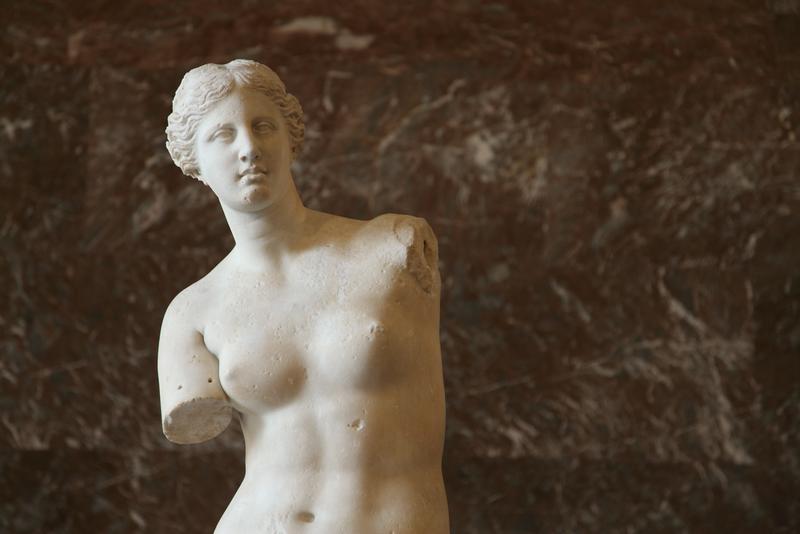Discovering The Venus de Milo
By | April 24, 2019

One of the most-recognized sculptures in the world, Venus de Milo is an exquisite example of ancient Greek art. The marble sculpture—believed to have been created by Alexandros of Antioch in the 2nd century BC—stands more than six and a half feet tall and shows a beautiful, nearly-nude woman. The only flaw to this stunning statue is that the arms are missing. That’s because the statue spent several centuries buried in a farm field on the island of Milos, crumbling and falling into disrepair, until it was unearthed in 1820. Let’s learn about how the Venus de Milo was found after all those years.

The Unknown Venus
Today, the Venus de Milo is one of the world’s best-known sculptures, so it is hard to believe that, for centuries, no one knew it even existed. Since its discovery in 1820, however, art historians have been able to piece together some information about the statue. They believe the Venus de Milo was the work of Alexandros of Antioch, an artist who traveled from city to city in ancient Greece, creating artworks on commission. He is also thought to have carved the statue of Alexander the Great which was also discovered on the island of Melos.

A Scavenged Find
Early in the morning of April 8, 1820, a farmer named Giorgos Kentrotas was scavenging his farm field on the Greek island of Melos, looking for discarded blocks of marble. There were lots of ancient ruins on the island and he used the stones for walls and buildings on his farm. In the next field over, there was a group of French naval officers who were searching for ancient artifacts. When Kentrotas pulled up part of a large marble statue instead of building block, the Frenchmen abandoned their work to see what the farmer had found.

A Wondrous Discovery
The naval officers, led by Olivier Voutier, urged Kentrotas to keep digging. The farmer, however, was growing concerned. He sensed that he had stumbled upon something important and valuable, but he feared the French would swoop in and claim the find. Still, he kept digging until the entire sculpture, minus the arms were unearthed. Additionally, a dedication plaque was found, along with a foundation base with the name of the sculptor.

Keeping the Statue Safe
The statue, in fragments, was housed in Kentrotas’ sheep barn for the time being. Voutier, who had a background in archaeology, contacted the French ambassadors in Smyrna and Constantinople about the discovery. He added that the French should buy the statue from the farmer as soon as possible, but that he did not have funds enough with him the cover the cost.

Negotiating a Price
The French offered Kentrotas 400 piasters for the statue. Before he could accept, other people joined in the negotiations. The Ottomans had an opinion over the worth of the statue, as did French Admiral Jules Dumont d’Urville. The French were desperate to acquire the sculpture. Eventually, they won the negotiation process and made plans to ship the statue to the Louvre Museum for restoration.

Restoring and Studying the Statue
The statue was made up of two main blocks of marble and several smaller pieces that appeared to have been carved separately. Her beauty and nudity led most art historians to believe that she was a depiction of the Greek goddess of love, Venus, and so she was named Venus de Milo, or Venus of Melos. A few others, however, argued that she could represent the goddess of the sea, Amphitrite. This Greek goddess was particularly important to the people of Melos. Based on the position of her shoulders, historians have speculated that her arms were outstretched and holding something. Since her arms have never been found, we do not know what she could have been holding. In addition, the art historians believe that the sculpture was originally painted with colorful paints and decorated with jewelry, as was popular during her day. Time underground, however, erased all traces of paint on the marble.

An Incomplete Masterpiece
Despite her missing arms, the Venus de Milo was immediately heralded as a masterpiece of ancient art. The statue was presented as a gift to King Louis XVIII who donated it to the Louvre Museum. During the restoration of the Venus de Milo, several art historians disagree on how the arms were originally placed. Since they could not agree, the museum decided it would not add restored arms to the statue and would, instead, display it as incomplete. The statue became world famous for its mastery, beauty, and missing arms.

The Louvre’s Prize Possession
For the last 199 years, the Venus de Milo has become one of the Paris museum’s most prized possessions, along with the Mona Lisa by Leonardo da Vinci. It remains one of the most popular attractions at the museum.

